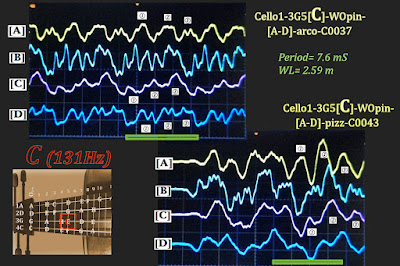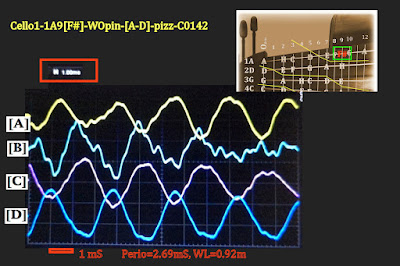[ 02/26/2023 ] Labels: 77c.Resonance-II
C(131Hz, WL=2.59m) resonance orbit of cello is special. Ordinarily resonance orbits in the 'Zone-III' are made up of 'double orbits' of 'Zone-II' tones, but C(or around C) notes differ.
Careful studies by oscilloscope could not detect 'double C'(two beats) but commonly found 'triple beats', this means G(394Hz)x3 make a C(131Hz, WL=2.59m) orbit wavelength. Simply to say, C(131Hz, 263Hz, of course 66Hz) orbits are not stable inside the cello body.
チェロの最低音(C)の1オクターブ上の C(131Hz)の共鳴軌道は特別だ。
一般的に Zone-IIIエリアでは、オクターブ上のZone-IIの共鳴軌道を2周する形で所定の共鳴波長を得ているが、C(およびその近辺)では事情が異なっているようだ。
オシロスコープデータを丹念に調べても、1周期当たりに2ビート(2周回)の波形は見つからず、実際は3ビート(または3ビートx2)であった。つまり、G(394Hz)の倍音軌道を3ケ連結してC(131Hz)の波長を得ている。C倍音(263Hz)の軌道・波長はチェロ筐体内で安定した位置をとれず、2個をチェロ筐体内に収めきれないことを示唆している。








_pz_C0118-2.jpg)





_pz_221129_C0100.jpg)
_pz_221129_C0104.jpg)

_pz_221129_C0088-1%E2%97%8F.jpg)

_pz_221129_C0088-2%E2%97%8F.jpg)
_pz_221129_C0084-1.jpg)



